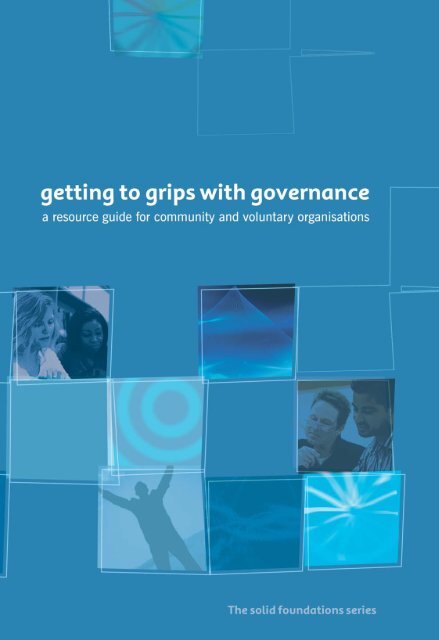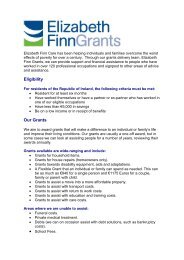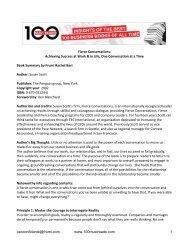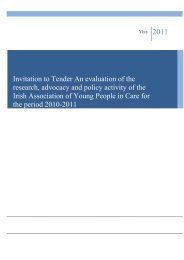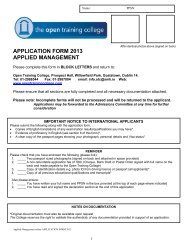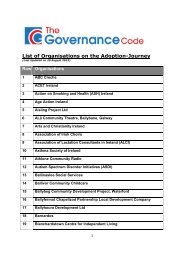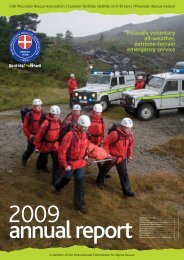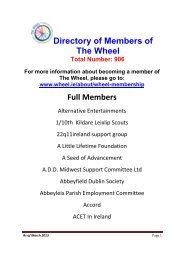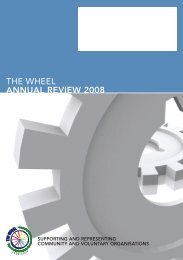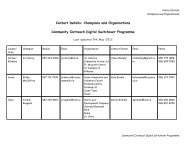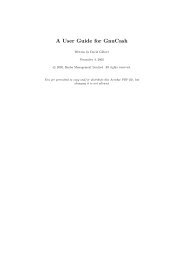Getting to Grips with Governance - The Wheel
Getting to Grips with Governance - The Wheel
Getting to Grips with Governance - The Wheel
You also want an ePaper? Increase the reach of your titles
YUMPU automatically turns print PDFs into web optimized ePapers that Google loves.
Preface Board of direc<strong>to</strong>rs, board of governors, board of<br />
management, board of trustees, committee, core group, council<br />
of management, executive committee, management committee …<br />
whatever they are called, governing bodies of community and<br />
voluntary organisations have a significant part <strong>to</strong> play in those<br />
organisations.<br />
1<br />
<strong>The</strong>y must ensure the organisation is<br />
both effective and accountable. Members<br />
of a governing body are there <strong>to</strong> oversee<br />
and take responsibility for everything an<br />
organisation does. It is an important role<br />
and one not be taken on <strong>with</strong>out an<br />
understanding of what is involved.<br />
However, it is not always easy for<br />
voluntary governing body members<br />
<strong>to</strong> find out exactly what they should<br />
be doing or how they should best<br />
carry out their duties.<br />
<strong>The</strong>re is an increasing demand from<br />
funding agencies, the state, the public,<br />
and others, for community and voluntary<br />
organisations <strong>to</strong> demonstrate their ability<br />
<strong>to</strong> perform <strong>to</strong> a high standard. <strong>The</strong>re are<br />
also impending changes in charity law and<br />
regulation, including new codes of practice<br />
for fundraising. Organisations must ready<br />
themselves now for these new challenges<br />
<strong>to</strong> enable them <strong>to</strong> strengthen their impact<br />
and build stakeholder confidence.<br />
<strong>Getting</strong> <strong>to</strong> <strong>Grips</strong> <strong>with</strong> <strong>Governance</strong> is part of<br />
a range of training and guidance services<br />
on governance provided by <strong>The</strong> <strong>Wheel</strong>.<br />
It follows on from our popular 2007<br />
publication Solid Foundations: a resource<br />
guide for building strong and effective<br />
organisations in the community and<br />
voluntary sec<strong>to</strong>r. It is accompanied by<br />
a sister publication on risk management<br />
entitled: Reducing the Risk.<br />
<strong>The</strong> guide has been designed <strong>to</strong> help<br />
governing body members by:<br />
• Providing information about the<br />
functions that a governing body<br />
performs<br />
• Assisting individuals <strong>to</strong> understand<br />
more about governing body roles and<br />
responsibilities and potential liabilities<br />
• Encouraging the development and<br />
improvement of practice<br />
• Signposting <strong>to</strong> further information<br />
and resources.<br />
We hope you find it useful. If you have any<br />
additional information for future editions or<br />
any comments or questions whatsoever,<br />
please do not hesitate <strong>to</strong> contact us.<br />
Deirdre Garvey<br />
Chief Executive Officer, <strong>The</strong> <strong>Wheel</strong>
2<br />
Publication details<br />
Based on <strong>The</strong> <strong>Wheel</strong> gratefully acknowledges the<br />
Scottish Council for Voluntary Organisation's permission<br />
<strong>to</strong> base this guide on its publication <strong>Getting</strong> <strong>to</strong> <strong>Grips</strong><br />
<strong>with</strong> <strong>Governance</strong>: guidance for governing bodies of<br />
small <strong>to</strong> medium sized voluntary organisations.<br />
Produced by Sandra Velthuis, Whitebarn Consulting<br />
Designed by Gráinne Murray<br />
Published by <strong>The</strong> <strong>Wheel</strong><br />
First edition 2008<br />
<strong>The</strong> <strong>Wheel</strong> is a support and representative body<br />
connecting community and voluntary organisations<br />
across Ireland. <strong>The</strong> <strong>Wheel</strong> is also a resource centre<br />
and forum, providing support, advocacy and leadership<br />
<strong>to</strong> individuals and organisations in the community and<br />
voluntary sec<strong>to</strong>r, as we believe they are vital<br />
components of a cohesive and healthy society.<br />
Disclaimer<br />
Our goal is <strong>to</strong> provide comprehensive, timely and<br />
accurate information. This publication contains<br />
references and pointers <strong>to</strong> information kept or provided<br />
by other organisations. We therefore cannot guarantee<br />
their accuracy. It is our policy <strong>to</strong> correct any errors<br />
brought <strong>to</strong> our attention. Comments and suggestions<br />
are always welcome.
contents<br />
Who this guide is for 6<br />
How <strong>to</strong> use this guide 6<br />
CHAPTER 1: <strong>The</strong> role of the governing body 7<br />
3<br />
1.1 Introduction 8<br />
1.2 What is governance? 8<br />
1.2.1 Defining governance 8<br />
1.2.2 Governors 8<br />
1.2.3 Clarifying which part of the organisation governs 8<br />
1.3 Why the governing body is necessary 9<br />
1.3.1 A long-term vision 9<br />
1.3.2 Overall responsibility 9<br />
1.4 <strong>Governance</strong>, management and operations 9<br />
1.4.1 Understanding the differences 9<br />
1.4.2 Marking the boundaries 9<br />
1.4.3 Dealing <strong>with</strong> multiple roles 11<br />
1.5 Core duties of the governing body 11<br />
1.5.1 Values and principles 11<br />
1.5.2 Clarity of direction 12<br />
1.5.3 Accountability 12<br />
1.5.4 Human resources 12<br />
1.5.5 Liaison 12<br />
1.5.6 Teamwork 13<br />
1.6 Collective responsibility 13<br />
1.6.1 Understanding the implications of collective responsibility 14<br />
1.6.2 'Non-governors' playing a governance role 14<br />
1.7 Individual responsibilities 15<br />
1.8 Responsibilities of office bearers 15<br />
1.8.1 Chairperson 16<br />
1.8.2 Secretary 16<br />
1.8.3 Treasurer 17<br />
1.9 Satisfying internal and external expectations of stakeholders 18<br />
1.9.1 Stakeholders 18<br />
1.9.2 Examples 18<br />
1.9.3 Transparency 21<br />
1.10 Handling competing expectations 21<br />
1.11 Summary 22
4<br />
CHAPTER 2: How the governing<br />
body does its work 23<br />
2.1 Introduction 24<br />
2.2 Adopting an appropriate structure 24<br />
2.2.1 Unincorporated 24<br />
2.2.2 Incorporated 24<br />
2.2.3 Making the right choice 24<br />
2.3 Understanding and using the governing document 25<br />
2.3.1 <strong>The</strong> governing document 25<br />
2.3.2 <strong>The</strong> governing body's responsibilities<br />
in relation <strong>to</strong> the governing document 25<br />
2.4 Having charity (CHY) status 26<br />
2.4.1 What it means 26<br />
2.4.2 Determining eligibility 26<br />
2.4.3 Future changes 26<br />
2.5 Meeting the needs of regula<strong>to</strong>rs 26<br />
2.6 Planning 28<br />
2.6.1 Mission and vision 28<br />
2.6.2 Strategic planning 29<br />
2.6.3 Operational planning 30<br />
2.6.4 Risk management 31<br />
2.6.5 Moni<strong>to</strong>ring, evaluation and review 32<br />
2.7 Agreeing internal policies 34<br />
2.7.1 Why have internal policies? 34<br />
2.7.2 <strong>The</strong> role of the governing body in policy-making 34<br />
2.8 Ensuring human resources are managed 35<br />
2.8.1 Duty of care 35<br />
2.8.2 Legislation 35<br />
2.8.3 Delegating human resource tasks 36<br />
2.9 Ensuring financial resources are managed 36<br />
2.10 Setting up subcommittees and working groups 39<br />
2.11 Holding effective meetings 40<br />
2.11.1 <strong>The</strong> 'Four Ps' 40<br />
2.11.2 Confidential matters 40<br />
2.11.3 Making meetings less dreaded 40<br />
2.12 Being creative 41<br />
2.13 Summary 42
CHAPTER 3: Developing the governing body 43<br />
5<br />
3.1 Introduction 44<br />
3.2 <strong>Getting</strong> the right people on board 44<br />
3.2.1 Size 44<br />
3.2.2 Eligibility 44<br />
3.2.3 Succession planning 44<br />
3.2.4 Recruitment 45<br />
3.3 Supporting members of governing bodies 46<br />
3.3.1 Induction 47<br />
3.3.2 Enhancing capacities 48<br />
3.3.3 <strong>Governance</strong> manual 49<br />
3.4 Review 50<br />
3.4.1 Performance reviews 51<br />
3.4.2 Review days 51<br />
3.4.3 External facilitation 51<br />
3.5 Summary 52<br />
APPENDICES: What next? 53<br />
Appendix 1: Resources from the Republic of Ireland 54<br />
1.1 <strong>The</strong> <strong>Wheel</strong> 54<br />
1.2 Bar Council 54<br />
1.3 Boardmatch Ireland 54<br />
1.4 Carmichael Centre for Voluntary Groups 54<br />
1.5 Combat Poverty Agency 54<br />
1.6 Corporate <strong>Governance</strong> Association of Ireland 54<br />
1.7 Irish Charities Tax Research Ltd 54<br />
1.8 Prospectus 54<br />
Appendix 2: Resources from the United Kingdom 55<br />
2.1 Association of Chief Executive Officers of Voluntary Organisations 55<br />
2.2 Charities Evaluation Services 55<br />
2.3 Direc<strong>to</strong>ry of Social Change 55<br />
2.4 National Council for Voluntary Organisations 55<br />
2.5 Scottish Council for Voluntary Organisations 56<br />
Appendix 3: Glossary of terms 59<br />
Appendix 4: <strong>Governance</strong> checklist 61<br />
Summary 64
6<br />
Who this guide for<br />
How <strong>to</strong> use this guide<br />
This guide has been prepared primarily<br />
<strong>to</strong> meet the needs of governing bodies of<br />
established organisations that are small<br />
<strong>to</strong> medium in size, as this reflects the<br />
vast majority of organisations in the Irish<br />
community and voluntary sec<strong>to</strong>r. Most of<br />
the material is also applicable <strong>to</strong> new and<br />
large organisations, but we recognise that<br />
there are some issues for governing bodies<br />
of these organisations that warrant<br />
particular attention. Further resources<br />
for new and large organisations are<br />
found in appendices 1 and 2.<br />
<strong>The</strong> guide has been written primarily for<br />
governing body members. However, good<br />
governance needs <strong>to</strong> be embedded in an<br />
organisation; senior staff and advisors may<br />
therefore also find it useful in their work<br />
<strong>with</strong> governing bodies.<br />
Some people using this guide will be<br />
new governing body members, whereas<br />
others will be more experienced and may<br />
be members of more than one governing<br />
body. Regardless of the amount of<br />
experience, new situations typically<br />
challenge understanding, knowledge<br />
and ability, and as a consequence there<br />
is always something new <strong>to</strong> learn, or<br />
improve. We hope that everyone using<br />
this guide will find something that meets<br />
his or her current interest or situation.<br />
<strong>The</strong> guide is divided in<strong>to</strong> four chapters:<br />
• One: <strong>The</strong> role of the governing body<br />
• Two: How the governing body<br />
does its work<br />
• Three: Developing the governing body<br />
• Appendices: What next?<br />
Each section contains a general discussion<br />
of the area, <strong>with</strong> '<strong>to</strong>p tips' and questions<br />
(in speech bubbles) <strong>to</strong> help readers relate<br />
the <strong>to</strong>pics covered <strong>to</strong> their own experience.<br />
<strong>The</strong> final section provides a list of useful<br />
resources and publications, a glossary of<br />
relevant terminology and a checklist.<br />
Detailed contents pages are also provided.<br />
You may want <strong>to</strong> read the guide from<br />
beginning <strong>to</strong> the end, but it is anticipated<br />
that many readers will find it most useful<br />
<strong>to</strong> dip in and out, referring <strong>to</strong> information<br />
as and when needed. You may wish <strong>to</strong><br />
commence by completing the governance<br />
checklist in appendix 4 <strong>to</strong> assess where<br />
your prime information needs are.
CHAPTER 1 :<br />
<strong>The</strong> role of the<br />
governing body<br />
7
8<br />
1.1 Introduction<br />
<strong>The</strong> role of the governing body is <strong>to</strong><br />
ensure that the organisation meets its<br />
aims as efficiently and effectively as<br />
possible. This chapter begins by defining<br />
what governance is. It then sets out why<br />
it is necessary <strong>to</strong> have a governing body<br />
and what it should do. It considers the<br />
responsibilities both of the governing<br />
body as a whole and of the individuals<br />
involved, including those holding specific<br />
posts. Finally, it explores the need <strong>to</strong> steer<br />
a course between different (sometimes<br />
competing) interests <strong>to</strong> meet the<br />
expressed goals of the organisation.<br />
1.2 What is<br />
governance?<br />
1.2.1 Defining governance<br />
<strong>Governance</strong> (sometimes referred<br />
<strong>to</strong> as 'corporate governance') can be<br />
described as the system that ensures<br />
the fit between the organisation's<br />
mission and its performance. In<br />
essence, governance is about being in<br />
control and taking overall responsibility<br />
for the work and actions of an<br />
organisation. Good governance occurs<br />
when an organisation uses transparent<br />
decision-making processes <strong>to</strong> direct its<br />
resources and exercise power in an<br />
effective and accountable way. <strong>The</strong><br />
governing body is there <strong>to</strong> account<br />
for what the organisation does and<br />
how it does it; the 'buck s<strong>to</strong>ps' <strong>with</strong><br />
those who govern an organisation.<br />
1.2.2 Governors<br />
<strong>The</strong> prime governors of an organisation<br />
are members of the governing body.<br />
Whether these individuals are called<br />
'management committee members',<br />
'direc<strong>to</strong>rs', 'trustees', or something<br />
else, will depend on the legal status<br />
and cus<strong>to</strong>m of the organisation.<br />
<strong>The</strong>ir titles matter little. What is<br />
more important is that the individuals<br />
involved, and others in the organisation,<br />
are clear about the duties and liabilities<br />
associated <strong>with</strong> their governance role.<br />
1.2.3 Clarifying which part<br />
of the organisation governs<br />
In some organisations <strong>with</strong> complex<br />
structures, there is the possibility<br />
of confusion about which part of the<br />
organisation is in fact the governing<br />
body - if, for example, they have both<br />
a management committee and an<br />
executive committee, or both a council<br />
and a board. It is imperative that<br />
everyone is clear which part of the<br />
organisation is the governing body.
1.3 Why the governing<br />
body is necessary<br />
1.3.1 A long-term vision<br />
<strong>The</strong> governing body makes a unique<br />
contribution <strong>to</strong> an organisation by<br />
focusing on the achievement of longterm<br />
aims. Whether the organisation is<br />
about making a difference in a specific<br />
geographic area, changing perceptions<br />
and attitudes, delivering a muchneeded<br />
service, or improving the<br />
quality of life for a particular group,<br />
the governing body is there <strong>to</strong> help<br />
the organisation realise its overall<br />
vision and its specific goals.<br />
1.3.2 Overall responsibility<br />
<strong>The</strong> governing body is that part of<br />
the organisation <strong>with</strong> formal power<br />
and responsibility. <strong>The</strong> powers and<br />
responsibilities are contained in the<br />
governing document (called either<br />
'constitution', 'deed of trust', 'rules'<br />
or 'memorandum and articles of<br />
association') and backed up by law.<br />
If things go wrong, it is the governing<br />
body that will be called <strong>to</strong> account.<br />
Members of the governing body need<br />
<strong>to</strong> be aware of this and act always in<br />
the best interests of the organisation,<br />
following all requirements of law and<br />
regulation. This is sometimes referred<br />
<strong>to</strong> as the need for 'due diligence'.<br />
1.4 <strong>Governance</strong>,<br />
management and<br />
operations<br />
1.4.1 Understanding<br />
the differences<br />
<strong>The</strong> governing body must govern;<br />
that is, it must provide leadership<br />
and strategy and must focus on the<br />
'big picture'. <strong>Governance</strong> is about<br />
planning the framework for work<br />
and ensuring it is done. As such,<br />
it is distinct from management<br />
(organising the work) and operations<br />
(doing the work). As far as possible,<br />
the governing body should therefore<br />
steer clear from making managerial<br />
decisions and getting involved in the<br />
day-<strong>to</strong>-day implementation of strategy.<br />
This is easier said than done.<br />
<strong>The</strong> lines between governance,<br />
management and operations are easily<br />
blurred, as they are of course closely<br />
inter-related.<br />
1.4.2 Marking the boundaries<br />
<strong>The</strong> larger an organisation is, the<br />
easier it is <strong>to</strong> define the boundaries.<br />
<strong>The</strong> governing body governs, the chief<br />
executive officer/senior management<br />
team manages, and the rest of the<br />
staff and volunteers engage in<br />
operations (see table). However, in<br />
smaller organisations, especially in<br />
those organisations <strong>with</strong>out paid staff,<br />
it is easy for the governing body <strong>to</strong> get<br />
9
10<br />
Governing body volunteers<br />
• Overview of organisation as a whole<br />
• Long-term direction<br />
• Frameworks for effective working<br />
• Accountable for actions and decisions<br />
Other volunteers and paid staff<br />
• Day-<strong>to</strong>-day operation of<br />
programme/projects<br />
• Short- <strong>to</strong> medium-term<br />
implementation of plans<br />
• Detailed planning and supervision<br />
• Responsible for delivery<br />
'bogged down' <strong>with</strong> questions of shortterm<br />
management and operations and<br />
<strong>to</strong> lose sight of the need <strong>to</strong> focus on<br />
strategy for the longer-term. In these<br />
situations, it is essential <strong>to</strong> find an<br />
effective way of balancing the<br />
demands for governance, management<br />
and operations, which are all crucial<br />
<strong>to</strong> the organisation's ultimate success.<br />
As small organisations grow in size<br />
and begin <strong>to</strong> take on paid staff, it is<br />
vital for governing body members,<br />
who are likely <strong>to</strong> have been used <strong>to</strong><br />
'pitching in', <strong>to</strong> concentrate on their<br />
governance role and <strong>to</strong> allow staff <strong>to</strong><br />
get on <strong>with</strong> the jobs for which they<br />
have been recruited.<br />
How does your organisation ensure<br />
sufficient attention is paid <strong>to</strong> longterm<br />
direction?<br />
Can you identify overlaps in<br />
governance between the governing<br />
body and paid staff?<br />
If so, what processes does your<br />
organisation have for joint working<br />
in those areas?<br />
*** TOP TIPS ***<br />
For organisations <strong>with</strong>out<br />
paid staff, try:<br />
Dividing the governing body's<br />
meeting agenda in<strong>to</strong> two sections,<br />
so there is always a slot for issues<br />
that concern progress <strong>to</strong>wards<br />
outcomes, overall accountability<br />
and financial sustainability,<br />
or<br />
Setting up a subcommittee of the<br />
governing body <strong>to</strong> focus on work<br />
programmes, delivery or operational<br />
matters. This could be open <strong>to</strong><br />
volunteers who do not currently<br />
serve on the governing body, as long<br />
as you have terms of reference that<br />
allow you <strong>to</strong> do this. Refer <strong>to</strong> the<br />
governing document if in doubt.


